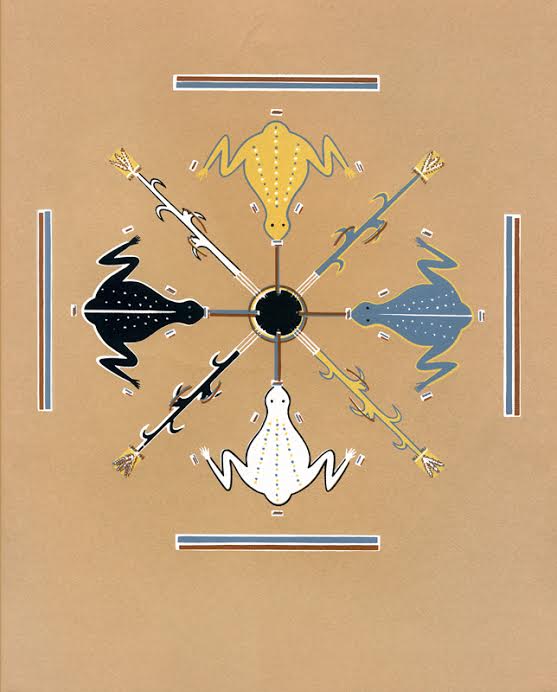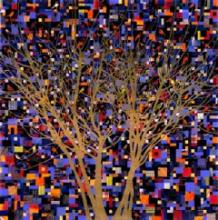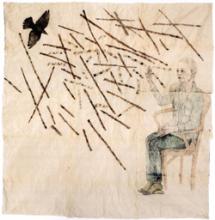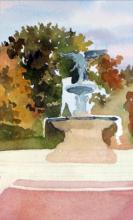ARAS Connections
Image and Archetype

Welcome
by Tom Singer
For most of you, this edition of ARAS Connections will be your first look at the new design of ARAS Online. When we first went online over a decade ago, I wrote about our tendency to think of online sites behaving in the same way we imagine Cheerios to appear on the shelf in the supermarket. They just spontaneously generate in place. When one package is gone, another one magically takes its place. But neither Cheerios nor the new ARAS Online site and ARAS Connections spontaneously generate. They are carefully crafted over a long period of time. Many hands and minds have collaborated to create the front end design (what you see on your computer screen) and the back end technology (what makes what you see on the screen possible).
This new version of ARAS Connections and ARAS Online is the result of the hard work of many people, especially Dyad Communications, John Kyle, Chris Miller, Carol Herbert, and Allison Tuzo. I talked with Allison to get her impressions of what has been central to the process—as Allison has been in the center of it all.
1. The redesign project began with a Pratt design class lead by David Walczyk spending a semester envisioning new ways for ARAS to present itself to the world. Their creative efforts framed and stimulated an extended discussion within ARAS on how best we could incorporate the newest advances in online design and technology. These lively exchanges resulted in our hiring Dyad Communications to do the creative work of redesigning our site. This process led to a more conscious articulation of our goals for the site:
a. To enhance the search capacities of the site to enable the easiest and quickest location of material within the archive itself and our rapidly growing library of articles and books.
b. To develop better ways of displaying the results of our enhanced search capacities. We wanted to offer varied ways of viewing images and their commentaries that would be responsive to the user’s wishes and needs at the moment.
c. To create a new “look” for ARAS Online and ARAS Connections with an aesthetic that reflects a vision of who we are and who we aspire to become.
2. After defining these goals with Dyad Communications, we assembled a team to realize the vision that they helped us articulate. John Kyle led the “back end” team, responsible for making all the technological advances. Dyad continued to lead the design efforts for the front end. Chris Miller was brought in to help with the migration of data into Drupal, a content management system that allows maximum flexibility in being able to continuously update, alter and add to ARAS Online. The migration of the data into Drupal proved to be one of the most difficult tasks because of the depth and breadth of material contained within the ARAS site.
In exploring ARAS Online you will soon discover that this has been a wonderfully successful project. We have a vastly improved site with enhanced search capacities as well as enhanced quality and ways in which to display images, commentaries, articles and books The site has many unique features that will delight users including much better organization of information. And, it is beautiful!!!
I have only one personal regret about our new site. We have had to say goodbye to our wonderful row of divine heads who, for over a decade, served as our “logo” on the homepage of both ARAS Online and ARAS Connections. I fought to save them because I became so attached to them as the “calling card” of ARAS that told the world we were dedicated to presenting archetypal, symbolic images from around the world. I am sad about this loss, but eventually accepted it in favor of the coherence and beauty of the new design. We bid our friends farewell as we send them off into the ether of cyberspace. They served us well.

Selections from the 2012 Art and Psyche in the City Conference
by Ami Ronnberg, Co-chair of ARAS Connections and member of the Art and Psyche Group
 It is a great pleasure to introduce the following articles by Diane Fremont and Aurélie Athan. They are part of our series of presentations from the Art and Psyche in the City conference, which was held at New York University and co-sponsored by ARAS in 2012. A common theme runs through both presentations – of finding spirit in matter. Diane Fremont reflects on the way spirit and body converge in the work of the New York artist Kiki Smith. Through the metaphor of the body as “clothing, vessel, and ground” Diane explores how the artist evokes the indwelling spirit, intimately and tenderly through her choice of materials and feminine forms. Aurélie Athan invites us to follow her on her walks through the city streets each week for a year from ARAS to her supervision with a Jungian analyst. She is delighted and surprised by the many fountains she finds on her way in the asphalt jungle of the city, offering joy and renewal through their flowing, cascading and life-giving waters.
It is a great pleasure to introduce the following articles by Diane Fremont and Aurélie Athan. They are part of our series of presentations from the Art and Psyche in the City conference, which was held at New York University and co-sponsored by ARAS in 2012. A common theme runs through both presentations – of finding spirit in matter. Diane Fremont reflects on the way spirit and body converge in the work of the New York artist Kiki Smith. Through the metaphor of the body as “clothing, vessel, and ground” Diane explores how the artist evokes the indwelling spirit, intimately and tenderly through her choice of materials and feminine forms. Aurélie Athan invites us to follow her on her walks through the city streets each week for a year from ARAS to her supervision with a Jungian analyst. She is delighted and surprised by the many fountains she finds on her way in the asphalt jungle of the city, offering joy and renewal through their flowing, cascading and life-giving waters.
Inspiriting body/Embodying spirit: The Art of Kiki Smith
by Diane Fremont
 My ongoing inquiry into the nature of creative process has led me to focus, in this paper, on the metaphor of the body as clothing, vessel and ground for the manifestation of spirit and, conversely, on the body’s agency in longing for and seeking to bring to life its own hidden, inner spirit. The work of Kiki Smith, one of the most intuitive and influential artists of her generation, draws the spirit deeply into a bodily feminine narrative on a number of levels, through media, method, style and content. Her intensive process transfigures this convergence of embodied spirit and inspirited body into an extraordinary array of symbolic forms, exemplifying a singularly feminine mode of creation.
My ongoing inquiry into the nature of creative process has led me to focus, in this paper, on the metaphor of the body as clothing, vessel and ground for the manifestation of spirit and, conversely, on the body’s agency in longing for and seeking to bring to life its own hidden, inner spirit. The work of Kiki Smith, one of the most intuitive and influential artists of her generation, draws the spirit deeply into a bodily feminine narrative on a number of levels, through media, method, style and content. Her intensive process transfigures this convergence of embodied spirit and inspirited body into an extraordinary array of symbolic forms, exemplifying a singularly feminine mode of creation.
Kiki Smith’s work is delicate, open and ephemeral but also humble, earthy, and broad ranging in its sources as well as in its influence. At times her work can also be dangerously bold and transgressive, as the dandelion’s weedy stealth, ubiquity, indomitability and even the name “dandelion”, meaning “lion’s teeth”, suggest. The childlike sense of wonder and trust we see in this photograph conveys Smith’s light, playful, trusting approach to her work, which, on the other hand, is by no means innocent, but deeply self-aware, with sophisticated psychological, political and historical insights as well as far-ranging art-historical references and sources. The spirited playfulness exemplified by Smith’s approach to her work evokes Winnicott’s well-known theory that play is the foundation of creative living and cultural life (102).
Read the full text of Inspiriting body/Embodying spirit: The Art of Kiki Smith.
A Lesson in Circulation: Spiritual Oases in the Concrete Jungle
by Aurélie Athan
 New York City is the home to countless fountains-- many of which are hidden gems while others are well-known celebrities. What is universal among these diverse oases is the water that flows through them in an endless loop. Each fountain performs its unique dance or poetry. Some drop from on high in a rushing whoosh or shoot up from bellow in syncopated spurts. Others camouflage themselves as sleek mirrors or pose as flowers. The largest weeps endlessly in memoriam.
New York City is the home to countless fountains-- many of which are hidden gems while others are well-known celebrities. What is universal among these diverse oases is the water that flows through them in an endless loop. Each fountain performs its unique dance or poetry. Some drop from on high in a rushing whoosh or shoot up from bellow in syncopated spurts. Others camouflage themselves as sleek mirrors or pose as flowers. The largest weeps endlessly in memoriam.
The fountain's message is an irresistible one, beckoning us to draw near especially in warmer weather. Fountains speak to the thirst of the parched psyche yearning for renewal of meaning, creativity, or joy (ARAS, 2010). They arrest our imagination asking us to stop, watch, listen, breathe, and bathe in their spray. Many of us walk by without noticing, too caught up in the pace of the city.
View the slideshow of A Lesson in Circulation: Spiritual Oases in the Concrete Jungle.
Read the full text.
The Poetry Portal
by Ellen Liberatori
 Dear Readers and Lovers of Poetry,
Dear Readers and Lovers of Poetry,
Thank you for your submissions to our last Invite to Write in which we explored the world of Bruegel's The Census at Bethelehem. We have chosen some for you to read here. Whether you read it, write it, or love to hear it, I hope poetry comes alive to all of you through the Poetry Portal. I feel it is an important service and duty to present what poetry is meant to be, that it be heard and read aloud. In the next few editions for the Poetry Portal, I will be using special themes for our invitations to write new and beloved poems of Ekphrasis. In this edition, I invite you all to write upon a Star and to hear the poem by the same name by Nobel Laureate Derek Walcott.
"Star", by Derek Walcott (5:21 am)
If, in the light of things, you fade
real, yet wanly withdrawn
to our determined and appropriate
distance, like the moon left on
all night among the leaves, may
you invisibly delight this house;
O star, doubly compassionate, who came
too soon for twilight, too late
for dawn, may your pale flame
direct the worst in us
through chaos
with the passion of
plain day.
Please send your poems inspired by Karen Arm's painting of stars to poetry@aras.org by July 15th.